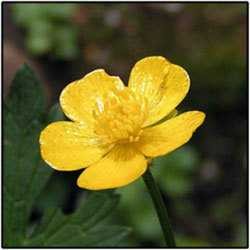Lapland buttercup
(Ranunculus demissus)

Description
Ranunculus lapponicus, the Lapland buttercup, is distributed all over the arctic, with the exception of northern and eastern Greenland. It is a low, prostrate plant with a creeping, underground stem (rhizome) which sends out long stalks and shoots bearing the flowers. The leaves are deeply tripartite, forming 3 lobes which are toothed or crenated. The flowers are yellow, solitary, generally having 6 (8) petals that are distinctly longer than the sepals. After flowering, the fruit forms a globular head of carpels held above the creeping plant. It grows in wet localities, especially in moss carpets along beaches, streams and lakes. Ranunculus is a large genus of about 600 species of flowering plants in the family Ranunculaceae. Members of the genus are known as buttercups, spearworts and water crowfoots. The familiar and widespread buttercup of gardens throughout Northern Europe (and introduced elsewhere) is the creeping buttercup Ranunculus repens, which has extremely tough and tenacious roots. Two other species are also widespread, the bulbous buttercup Ranunculus bulbosus and the much taller meadow buttercup Ranunculus acris. In ornamental gardens, all three are often regarded as weeds. Buttercups usually flower in the spring, but flowers may be found throughout the summer, especially where the plants are growing as opportunistic colonizers, as in the case of garden weeds. The water crowfoots (Ranunculus subgenus Batrachium), which grow in still or running water, are sometimes treated in a separate genus Batrachium ("frog"). They have two different leaf types, thread-like leaves underwater and broader floating leaves. In some species, such as R. aquatilis, a third, intermediate leaf type occurs. Ranunculus species are used as food by the larvae of some Lepidoptera species including the Hebrew character and small angle shades. Some species are popular ornamental flowers in horticulture, with many cultivars selected for large and brightly coloured flowers. Buttercups are mostly perennial, but occasionally annual or biennial, herbaceous, aquatic or terrestrial plants, often with leaves in a rosette at the base of the stem. In many perennial species runners are sent out that will develop new plants with roots and rosettes at the distanced nodes. The leaves lack stipules, have petioles, are palmately veined, entire, more or less deeply incised, or compound, and leaflets or leaf segments may be very fine and linear in aquatic species.
Taxonomic tree:







